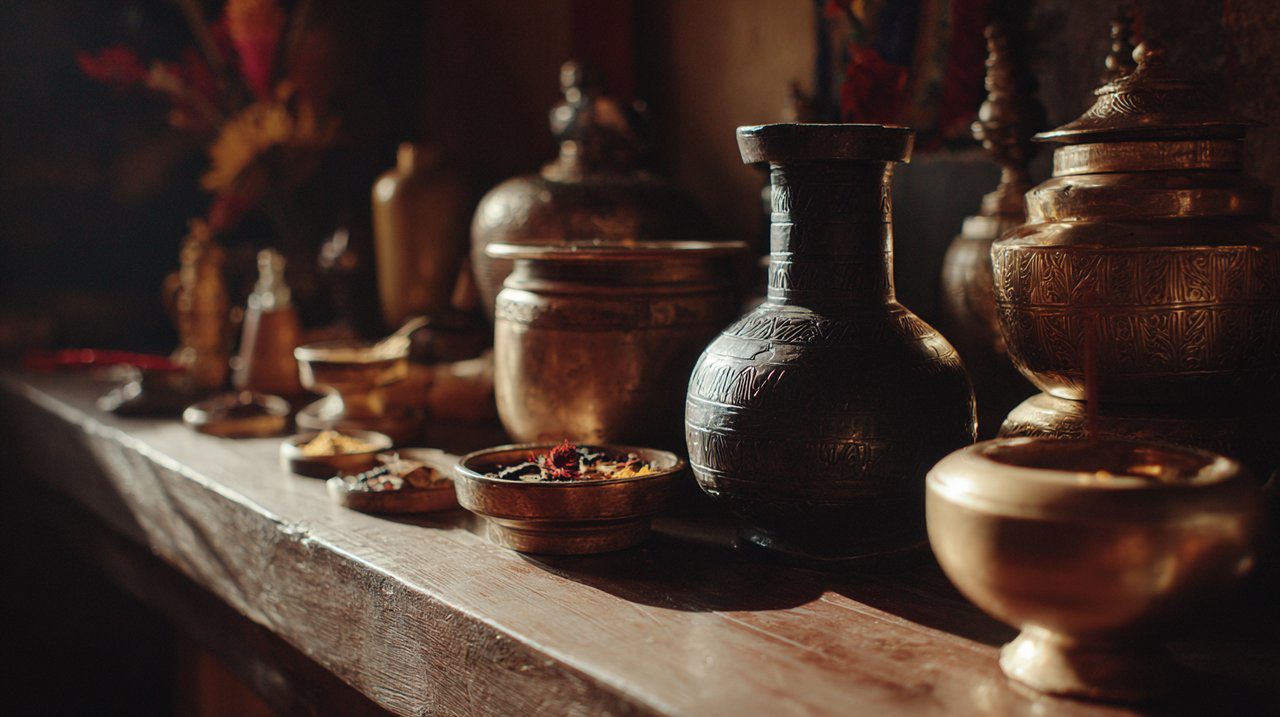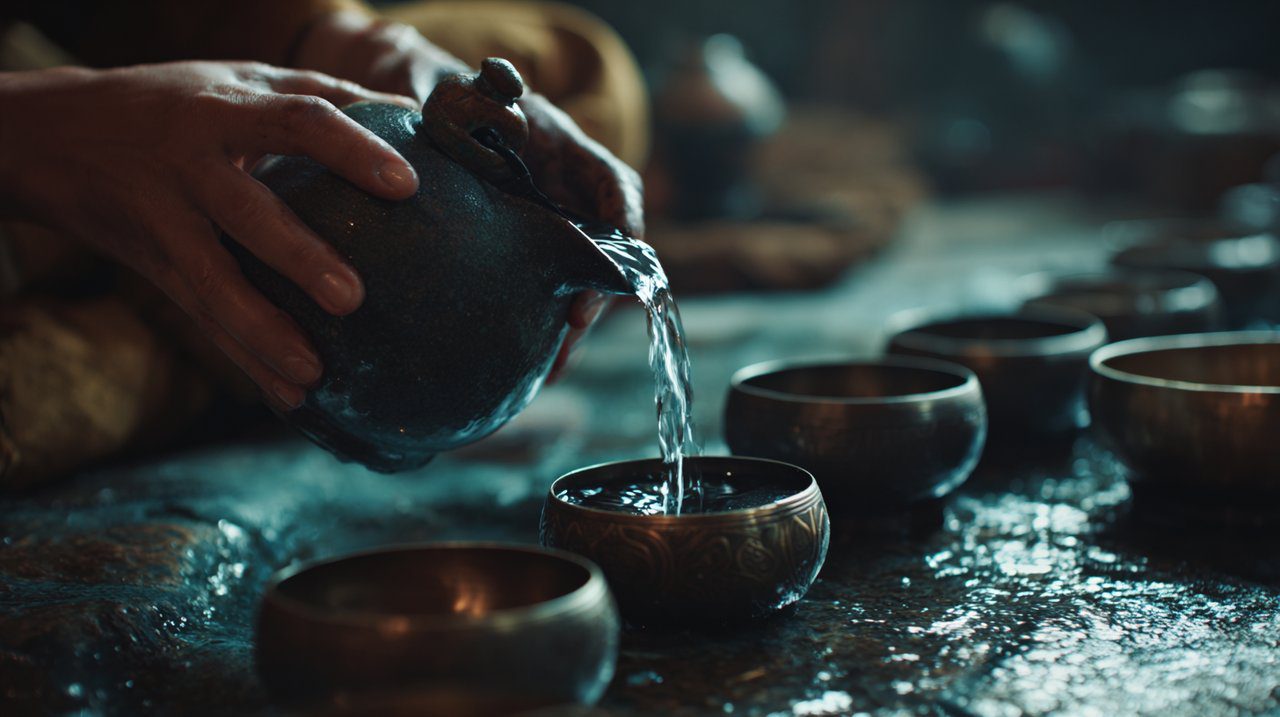Tibetan Ritual Vessels: Micro-Rituals for Inner Stillness
In our quiet moments, we often seek a gentle anchor—something tangible to ground our awareness amidst life’s flowing currents. Many believe true tranquility requires grand gestures or distant retreats. Yet, I invite you to consider a different, more accessible path. We can find profound peace in the simplest of actions, elevating everyday objects into powerful tools for presence. This is the very essence of micro-rituals: a gentle practice of infusing daily life with intention and reverence. Today, let us turn our gaze to Tibetan pots and other Tibetan ritual vessels. We approach them not as esoteric symbols, but as serene companions on our journey to inner calm. We will explore how these beautiful forms can gently guide us to moments of deep focus, transforming the ordinary into the sacred through the mindful act of their use.

The Sacred Vessel as a Mindfulness Tool
Imagine a quiet moment: a gentle touch, a focused breath. These are the delicate threads that weave together our experience of mindfulness. Sacred vessels from the Tibetan tradition offer us a unique and profound opportunity to cultivate this very awareness. They are not merely decorative items for display. Instead, they serve as gentle invitations to slow down, to deeply engage our senses, and to bring a mindful presence to each and every gesture. The true power, you see, lies not in the object itself, but in the conscious engagement and reverence we bring to it.
Beyond Form: Ritual as Intentional Practice
At its heart, ritual is a sequence of deeply intentional actions. When we approach a Tibetan pot or Buddhist offering bowls, we are doing more than just handling an object. We are engaging in a practice that gently encourages us to be fully, completely present. This cultivated presence transforms a simple act into a profoundly meaningful ritual. The vessel itself becomes a focal point, drawing our awareness to the delicate movements of our hands, the subtle sounds around us, and the quiet, beautiful unfolding of our inner landscape.
Typology of Sacred Vessels: Meanings and Manifestations
Within the rich tradition of Tibetan Buddhism, various vessels serve distinct and sacred purposes. Each is imbued with spiritual significance, and thoughtfully designed to support specific meditative practices. Understanding their unique roles can profoundly deepen our connection to the micro-rituals we choose to create.
Water Offering Bowls: Purity and Accumulation
Often seen in sets of seven, these small, elegant bowls are perhaps among the most common and accessible offering vessels. They carry deep symbolism, representing the seven royal possessions or the seven aspects of enlightenment. The act of filling them with water is a profound gesture of purification and generosity. Each individual bowl represents a specific offering:
- Drinking water
- Bathing water
- Flowers
- Incense
- Light
- Perfume
- Food
The clear water itself beautifully signifies purity, fluidity, and the boundless potential for all good qualities to manifest within us and around us.

Mandala Offering Plates: Universe in Miniature
The mandala offering plate is a layered, circular vessel, a profound tool used to symbolically offer the entire universe—both real and imagined—to the Buddhas and Bodhisattvas. This practice is designed to help us reduce attachment and cultivate immense, boundless generosity. The layers are typically filled with grains, precious stones, or even simple rice, each representing grand elements like mountains, continents, and celestial bodies. This deeply symbolic offering gently reminds us of the intricate interconnectedness of all existence.
Treasure Vases (Bumpa): Abundance and Purification
Treasure vases, or Bumpa, are beautifully ornate vessels, often bell-shaped with a gracefully narrow neck. They are carefully filled with precious substances, sacred pills, and heartfelt prayers, then sealed with reverence. These vases are consecrated with the intention to attract abundance, purify negative energies, and restore harmony to our environment. Their very presence is believed to gently draw in blessings and prosperity. Much like Dzi beads are revered for their protective and auspicious qualities, treasure vases embody a similar sacred power, attracting benevolent energies and fostering overall well-being.
Crafting Micro-Rituals: Engaging with Tibetan Vessels
The Water Offering: A Sensory Guide
To begin this practice, choose one or more offering bowls. Find a quiet, undisturbed space where you feel settled. Start by gently wiping the bowls clean with a soft cloth. Take a moment to truly feel the smooth, cool surface beneath your fingers.
- Preparation: Pour fresh, clear water into a pitcher. As you hold the pitcher, notice its weight in your hand, and observe the beautiful clarity of the water within.
- Filling: Slowly, deliberately, pour water into the first bowl. Close your eyes for a moment, and truly listen to the gentle trickle of the water as it fills. Then, open your eyes and watch the surface rise, stopping just below the rim, leaving a small space for the breath of air.
- Placement: With mindful intention, place the filled bowl on your shrine or chosen spot. Observe its stillness. Repeat this process for each bowl, allowing each filling to be a unique moment of focused attention. Feel the cool water, hear its sound, and see its pristine quality.
This simple, repeated act then transforms into a profound meditation on generosity and purification.
Intention and Repetition: Echoes of mala beads
Each time you engage with one of these vessels, gently set a clear intention. Perhaps it is for peace within your heart, for clarity of mind, or for boundless compassion towards all beings. This profound intentionality elevates the action far beyond mere routine. The rhythmic repetition of filling the bowls, much like counting mantras with mala beads, naturally calms the mind and deepens your focus. Allow each pour to be a quiet affirmation, and each placement a moment of mindful presence. It is this steady, consistent return to your intention that truly builds its transformative power.
Turning the Wheel of Merit: Parallel to tibetan prayer wheels
The act of making offerings, even a simple water offering, is considered a beautiful way to accumulate positive karma or merit. This practice is akin to the serene act of spinning tibetan prayer wheels. Just as the prayer wheel gently disseminates blessings with each turn, your mindful offering—imbued with pure and heartfelt intention—extends positive energy into your environment and into your very being. It is a quiet, yet profoundly powerful, act of contribution to the world.
Extending Sacredness: Ritual Beyond the Shrine
Everyday Objects, Sacred Intent
Consider for a moment how you handle your morning tea cup, or the pen you write with throughout your day. Can you bring the same gentle attention and profound reverence to these everyday items as you would to a sacred offering bowl? Pouring your tea with awareness, sipping it mindfully, or even the simple act of placing your cup down can each become a micro-ritual. Remember, the object itself is not inherently sacred; it is your awareness, your intention, and your presence that imbue it with sacredness.
Energetic Resonance: A Kinship with healing crystals
Just as healing crystals are often believed to hold and amplify certain energies, our ritual vessels, through consistent and mindful use, can become imbued with a palpable sense of peace and deep presence. This is not magic, but rather the cultivation of a resonant field through sustained and pure intention. Over time, you may notice that the space where you perform these micro-rituals begins to feel different—more settled, more serene, and more inviting to stillness. This gentle energy naturally extends outward, subtly influencing and enriching your entire surroundings.

Cultivating Inner Stillness: A Journey’s End
Our exploration of Tibetan pots and Buddhist offering bowls reveals a profound and beautiful truth: the path to inner peace is most often paved with simple, intentional actions. Through the gentle practice of micro-rituals, we learn to transform the mundane moments of life into opportunities for deep spiritual connection. These sacred vessels are not distant, esoteric artifacts. Instead, they are accessible, tangible tools for cultivating focus, generosity, and a profound inner calm in our daily lives. They serve as a gentle reminder that true reverence emerges from mindful engagement, not from complexity or grandeur. As you begin to integrate these practices, you may find yourself becoming more attuned to the subtle beauty and quiet magic of your everyday world. Perhaps you feel inspired to explore other avenues of mindful living, seeking further tools or teachings that resonate with this newfound stillness. The journey inward is rich and ever-unfolding, always inviting you to take a deeper breath, offer a softer touch, and embrace a more present heart. This is the quiet wisdom of micro-rituals, accessible to all, waiting to be discovered in your own hands.
💡 Frequently Asked Questions
Tibetan ritual vessels, such as pots and offering bowls, are tangible objects that can be used as tools for mindfulness. By engaging with them through simple, intentional actions, individuals can cultivate presence, slow down, and find moments of deep focus and inner calm.
Tibetan water offering bowls, often in sets of seven, symbolize purity and generosity. The act of filling them with water represents purification and the manifestation of good qualities. The ritual involves mindfully filling each bowl with clear water, paying attention to the sensory experience, and placing them with intention, transforming a simple act into a meditation.
Mandala offering plates are used to symbolically offer the entire universe, helping to reduce attachment and cultivate generosity. Treasure vases (Bumpa) are filled with precious substances and prayers to attract abundance, purify negative energies, and restore harmony, embodying a sacred power similar to Dzi beads.
Micro-rituals are simple, intentional actions that infuse daily life with reverence and presence. The article suggests that everyday objects, like a tea cup or a pen, can become sacred through mindful engagement, similar to how Tibetan ritual vessels are used. The awareness and intention brought to the action are what imbue the object with sacredness.
The rhythmic repetition involved in engaging with Tibetan ritual vessels, such as filling offering bowls, is compared to counting mantras with mala beads, which helps calm the mind and deepen focus. The act of making offerings is also likened to spinning Tibetan prayer wheels, as both practices are seen as ways to accumulate merit and extend positive energy.








